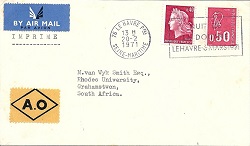
Introduction
Rates for overseas mail are extremely complex at the time of the stamp Marianne de Béquet. Actually, to calculate the postal charge of a mailing abroad, it is necessary to take into account:
- Tariff changes, with eight modifications between January 4, 1971 and May 15, 1978 (some of them only concerning a single country however);
- The geographical situation of the country addressee: besides the general case, there are special rates for the countries of the European Union, Canada, ... and the particular case of countries assimilated to the internal mail regime (roughly speaking, the former French colonies);
- Whether air traffic is used or not, for the calculation of a surcharge fee linked to the weight of the mailing and to the existence of seven geographical areas named A, B, C, D, E, F and G and defined as follows:
- area A : Europe, Turkey, the Azores, the Canary Islands, Madeira, Cyprus;
- area B : Algeria, Morocco, Tunisia;
- area C : the Afars and the Issas, Benin (formely Dahomey), Cameroon, Central African Republic, Congo (Brazzaville), Côte d’Ivoire, Gabon, Guadeloupe, Guinea, French Guiana, Upper Volta, Mali, Martinique, Mauritania, Niger, Réunion, Senegal, Chad, Togo;
- area D : the Comoros, Madagascar, Laos, South Vietnam , New Caledonia, New Hebrides, Khmer Republic, Saint-Pierre-et-Miquelon, French Southern and Antarctic Lands, Wallis and Futuna;
- area E : Saudi Arabia, Iran, Iraq, Israel, Jordan, Lebanon, Libya, United Arab Republic, Syrian Arab Republic;
- area F : Burma, People’s Republic of China, Korea, Hong Kong, Indonesia, Japan, Macao, Malaysia, People’s Republic of Mongolia, Philippines, Singapore, Taiwan, Thailand, Timor, Democratic Republic of Vietnam, Australia, New Zealand, other countries of Oceania;
- area G : other countries in Africa, in America and in Asia;
- area A : Europe, Turkey, the Azores, the Canary Islands, Madeira, Cyprus;
- The type of mailing: letter, postcard, printed matter, registered mail, EXPRÈS mail, ...
- The distinction between mainland France and the overseas territories for the place where mail is deposited.
In this article, we will distinguish three categories of countries: those of the general regime, those of the particular regime of countries assimilated to the internal mail regime and those benefiting from special rates. We will show a number of covers by explaining the reasons of the applied rate. We will also present a number of covers to Switzerland, in order to illustrate the complexity of rates over the period 1971 to 1978. Finally, a number of specific cases will be described in a last part entitled Miscellaneous.
We will describe the main postal rates in the form of numerous tables and will show a number of covers by explaining the reasons of the applied rate.
| date | registered mailing | EXPRÈS mailing | declared value mailing | ||||
|---|---|---|---|---|---|---|---|
| fixed fee | acknowledgement of receipt | insurance proportional cost by 350 F increment | minimum tax | maximum charge | |||
| requested when tabling | requested subsequently to the deposit | ||||||
| 4.1.71 | 3,00 F | 1,00 F | 2,00 F | 3,50 F | 0,90 F | 3,00 F | 7 500 F |
| 16.9.74 | 4,70 F | 1,50 F | 3,00 F | 6,20 F | - | ? | - |
| 1.1.76 | - | - | - | - | 1,80 F | ? | 10 000 F |
| 2.8.76 | 5,50 F | 2,00 F | 4,00 F | 7,50 F | - | ? | 15 000 F |
| 15.5.78 | 6,50 F | 2,50 F | 5,00 F | 9,00 F | 2,00 F | ? | - |
It should be noted that the rates described in the above table are independent from the country addressee.
| date | letters, postcards, values to be recovered, … per 5 g increment | other items per 25 g increment | ||||||
|---|---|---|---|---|---|---|---|---|
| Madagascar, the Comoros | Mauritius | area A | other countries | Madagascar, the Comoros | Mauritius | area A | other countries | |
| 10.1.1970 | 5,00 F CFA | 5,00 F CFA | 20,00 F CFA | 25,00 F CFA | 5,00 F CFA | 5,00 F CFA | 20,00 F CFA | 25,00 F CFA |
| 1.8.1971 | 5,00 F CFA | 5,00 F CFA | 20,00 F CFA | 25,00 F CFA | 5,00 F CFA | 5,00 F CFA | 20,00 F CFA | 25,00 F CFA |
| 16.8.1974 | 5,00 F CFA | 5,00 F CFA | 20,00 F CFA | 25,00 F CFA | 5,00 F CFA | 5,00 F CFA | 20,00 F CFA | 25,00 F CFA |
| 1.1.1975 | 0,10 F | 0,10 F | 0,40 F | 0,50 F | 0,10 F | 0,15 F | 0,40 F | 0,45 F |
